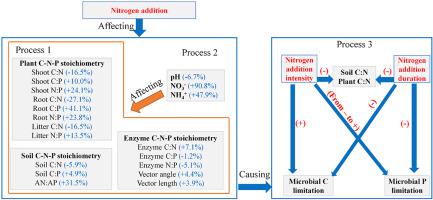Soil Biology and Biochemistry ( IF 9.7 ) Pub Date : 2022-05-21 , DOI: 10.1016/j.soilbio.2022.108714 Hongwei Xu , Qing Qu , Guanwen Li , Guobin Liu , Violette Geissen , Coen J. Ritsema , Sha Xue

|
Global atmospheric nitrogen deposition significantly affects the nutrient cycling and C–N–P stoichiometry in ecosystems. Herein, a global meta-analysis was conducted based on 898 pairwise observations to analyze the impact of nitrogen addition on plant-soil-enzyme C–N–P stoichiometry and microbial nutrient limitation in different ecosystem types (cropland, grassland, and forest), nitrogen addition intensity (0–5, 5–10, and >10 g N m−2 yr−1) and duration (0–5, 5–10, and >10yr). Results showed that nitrogen addition significantly decreased plant C:N (shoot: 16.5%, root: 27.1%, litter: 16.5%), soil C:N (5.9%), enzyme C:P (1.2%), and enzyme N:P (5.1%), whereas significantly increased soil C:P (4.9%), enzyme C:N (7.1%), vector angle (4.4%), vector length (3.9%), and plant N:P (shoot: 24.1%, root: 23.8%, and litter: 13.5%). Furthermore, nitrogen addition mainly affected the enzyme C:N and vector length in grasslands. Additionally, the changes in C:N in plants, soil, and enzymes, and vector angle and length were higher at nitrogen addition intensity of >10 g N m−2 yr−1. The changes in C:N and C:P in plant and soil were higher at nitrogen addition duration of >10 yr. Finally, the N:P in shoot, soil and enzyme, and vector angle were strongly correlated with mean annual precipitation (MAP). In conclusion, nitrogen addition significantly reduced the C:N ratio in plants and soil and increased plant N:P, and microbial C and P limitation. These effects vary with the ecosystem type, MAP, and nitrogen addition intensity and duration. The results improve our understanding of the plant-soil-microbial nutrient cycling processes in terrestrial ecosystems under global nitrogen deposition.
中文翻译:

氮添加对植物-土壤-酶 C-N-P 化学计量和微生物养分限制的影响
全球大气氮沉降显着影响生态系统中的养分循环和 C-N-P 化学计量。在此,基于 898 个成对观察结果进行了一项全球荟萃分析,以分析氮添加对不同生态系统类型(农田、草地和森林)中植物-土壤-酶 C-N-P 化学计量和微生物养分限制的影响,氮添加强度(0-5、5-10 和 >10 g N m -2 yr -1) 和持续时间(0-5、5-10 和 >10 年)。结果表明,施氮显着降低了植物 C:N(芽:16.5%,根:27.1%,凋落物:16.5%)、土壤 C:N(5.9%)、酶 C:P(1.2%)和酶 N: P(5.1%),而显着增加土壤 C:P(4.9%)、酶 C:N(7.1%)、载体角度(4.4%)、载体长度(3.9%)和植物 N:P(芽:24.1 %,根:23.8%,凋落物:13.5%)。此外,氮添加主要影响草地中的酶C:N和载体长度。此外,在氮添加强度 >10 g N m -2 yr -1时,植物、土壤和酶中 C:N 的变化以及载体角度和长度的变化更高。. 植物和土壤中 C:N 和 C:P 的变化在氮添加持续时间 > 10 年时更高。最后,枝条、土壤和酶中的 N:P 以及载体角度与年平均降水量 (MAP) 密切相关。总之,氮添加显着降低了植物和土壤中的 C:N 比,增加了植物 N:P 和微生物 C 和 P 限制。这些影响因生态系统类型、MAP 以及氮添加强度和持续时间而异。这些结果提高了我们对全球氮沉降下陆地生态系统植物-土壤-微生物养分循环过程的理解。


























 京公网安备 11010802027423号
京公网安备 11010802027423号